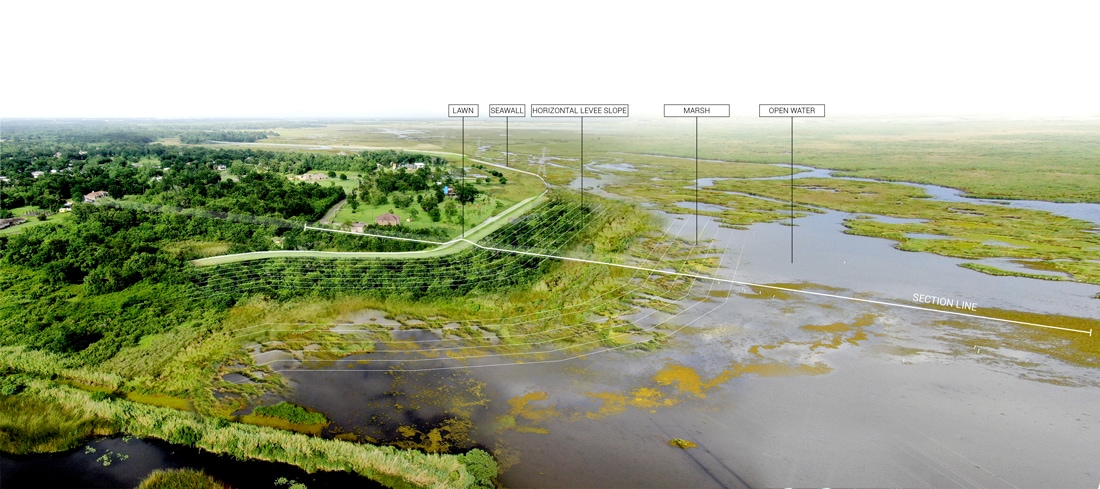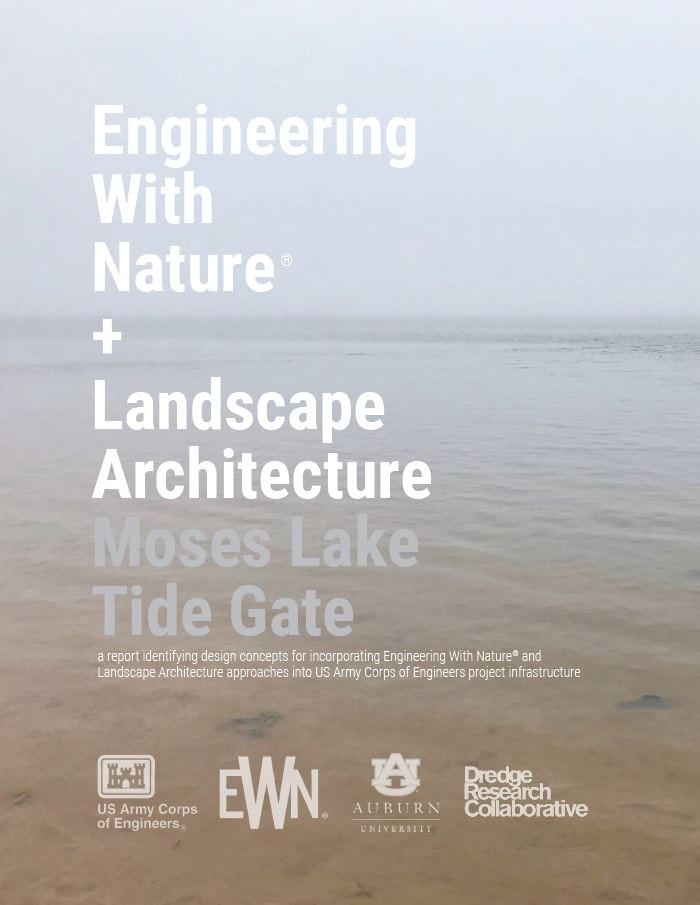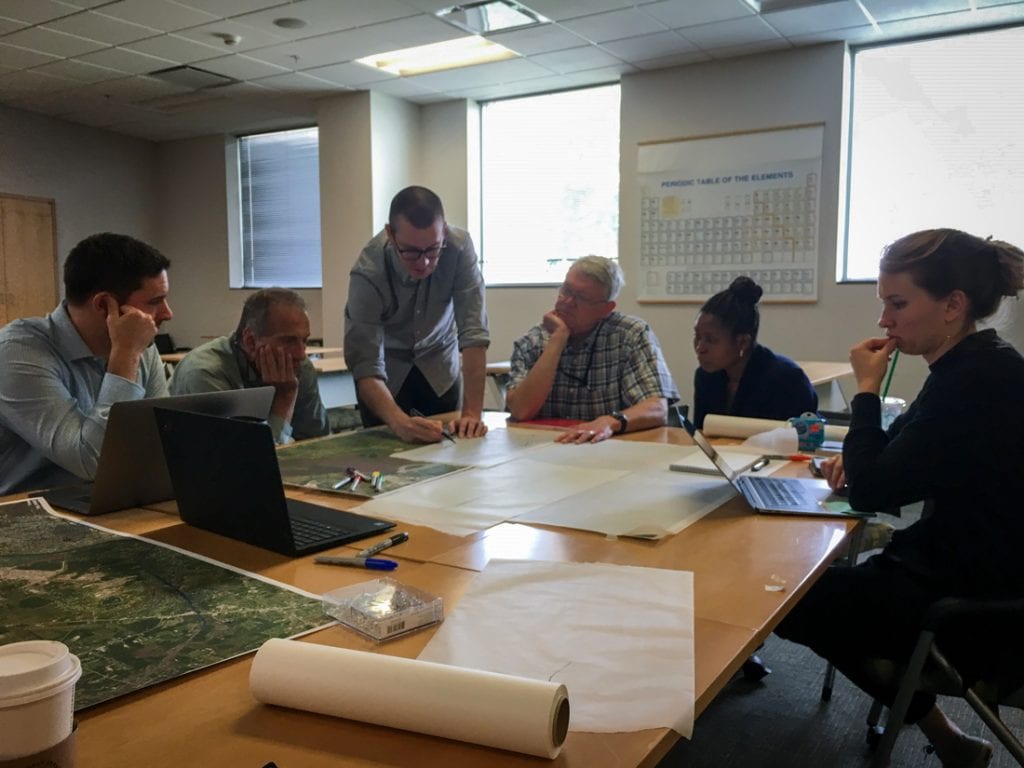The EWN initiative continually seeks opportunities to provide the public with examples of water resources infrastructure that incorporates innovative designs and measures that are consistent with EWN principles. This page highlights many of the EWN designs that have been identified for a variety of different USACE activities.
Our multidisciplinary team has developed innovative approaches for USACE infrastructure projects, achieving engineering goals while enhancing environmental and social benefits. By synthesizing EWN ideas through workshops and engagements, we’ve created drawings, renderings, and reports showcasing various water resource projects and the integration of these innovative concepts. Explore this webpage and associated reports to discover EWN opportunities, and revisit periodically for updates on new design products.

The reports offered in this section are the products of USACE District project, engineering and study teams that explored possible opportunities to incorporate additional project benefits. In doing so, the teams identified a variety of ideas that incorporate EWN techniques and landscape architectural practices. Economic, social and environmental benefits are outcomes of that work, and those results are described in the following EWN/LA reports.
Beginning in July 2019, the Engineering With Nature® and Landscape Architecture project delivery team (EWN®-LA PDT) participated in a workshop hosted by the USACE’s Philadelphia District (NAP) in which an array of potential NNBF design concepts and EWN strategies were developed for further consideration. Seven design concepts were prioritized to include more details, and these designs were then further refined during additional study and analysis. Over the next nine months, these concepts were evaluated with respect to application in the NJBB regions. The report details the results of those findings and also includes possible methods for pairing NNBF with non-structural measures to obtain coastal storm risk management (CSRM) and ecological benefits.
This R&D report offers information on the innovative design concepts that were identified for components of the Sabine to Galveston (S2G) Project, which is a project of the Galveston District (SWG), US Army Corps of Engineers (USACE). These design concepts combine Engineering With Nature® (EWN®) and landscape architectural (LA) approaches to infrastructure design in order to identify opportunities to incorporate “Natural and Nature-Based Features” (NNBF) into proposed S2G Project infrastructure.
In fall 2018, the Engineering With Nature® and Landscape Architecture project delivery team (EWN®-LA PDT) began working with New Orleans District (MVN), USACE to develop recommendations for how the on-going design and construction of the canal might incorporate EWN® principles and NNBF. This R&D report offers information on the innovative design concepts that were identified for Comite Canal.
In fall 2018, the Engineering With Nature® and Landscape Architecture project delivery team (EWN®-LA PDT) began working with Jacksonville District (SAJ), USACE to develop recommendations for how the W.P. Franklin Lock and Dam project area and Moore Haven Lock and Dam project area might incorporate EWN principles and NNBF. This R&D report offers information on the innovative design concepts that were identified for these two project areas.
In fall 2018, the Engineering with Nature® and Landscape Architecture project delivery team (EWN®-LA PDT) began working with the Baltimore District of the US Army Corps of Engineers to develop recommendations for repairing jetties in Chesapeake Beach, Maryland, at the mouth of Fishing Creek; and in Annapolis, Maryland, at the mouth of Back Creek. This study has examined alternative options, which are intended to both maintain the navigation-related performance criteria for the jetties and to provide enhanced ecological value on or in the vicinity of the jetties.

In January 2019, the Engineering with Nature® and Landscape Architecture project delivery team (EWN®-LA PDT) began working with Galveston District of the US Army Corps of Engineers to develop recommendations for protecting the shoreline areas near the Moses Lake Tide Gate. This study examined options for increasing resilience in the vicinity of the tide gate while also integrating additional environmental and social benefits. This R&D report offers information on the design concepts that were identified for the project area.
Producing LA renderings is a valuable technique that can be leveraged to convey information about a project and its integration with the surrounding environment. Using standard orthographic and perspectival representation techniques including plan, section-elevation, section-perspective, and aerial perspective, LA renderings can depict the intended conditions of a completed project. Various dimensions of a proposed project, such as how it would be experienced by recreational users, how it would provide engineering benefit, and how it might develop as habitat for plant and animal species, can also be illustrated within renderings and described by annotations layered on top of renderings. LA renderings can also be used to make before-and-after comparisons between existing conditions [captured in photographs] and proposed conditions [shown in the renderings]. Such drawings can offer diverse audiences, which include decision-makers, project planners, and the general public, greater insight into future-anticipated changes to environmental conditions and/or the addition of human-use benefits.
The following designs and renderings are derived from the EWN/LA reports listed on this page. The images are included here as independent files for use when illustrating a broad range of EWN techniques.
Engineers and scientists that practice EWN are knowledgeable about natural and engineering processes, and they appreciate the “value added” when integrating the two to support a water-based, infrastructure project. Adding landscape architects to our team resulted in another layer of capability, and therefore, expanded the possibilities to identify EWN options for projects. Landscape architects (LAs) are formally trained to think about how people interact with a design. LAs also translate the conceptual stage of a project directly into a specific drawing by using a visual vocabulary for communicating how natural processes can be integrated into traditional engineering projects. Given the complimentary nature of disciplines that are required, and mutual interest in infrastructure enhancement, a collaborative effort was initiated to further promote those shared design principles and precedent knowledge. Thus, EWN strategies are collaboratively pursued by engineers, hydrologists, biologists, ecologists and landscape architects.

The EWN initiative is grateful to the Dredge Research Collaborative (DRC) for their collaboration and partnership in the development of the renderings and reports that are showcased on this page as well as for their collaboration and partnership over the years and with development of EWN Podcast Season 2 Episode #2. As members of the DRC, Rob Holmes, Sean Burkholder, Brian Davis, Justine Holzman and Gena Wirth have contributed greatly to the success of this EWN collaboration. Collaborations between the DRC’s landscape architects and ERDC’s scientists and engineers began in summer 2017. Since that time, the team has pursued numerous projects that have incorporated EWN concepts into traditional water resources infrastructure. For more information about the DRC, please visit: https://dredgeresearchcollaborative.org/
Brey, J. 2022. The Long Game. Landscape Architecture Magazine, 112(11). https://landscapearchitecturemagazine.org/2022/11/09/the-long-game/

Engineering With Nature® is the intentional alignment of natural and engineering processes to efficiently and sustainably deliver economic, environmental, and social benefits through collaboration.